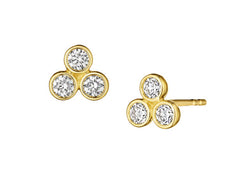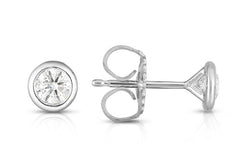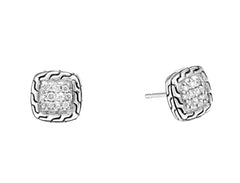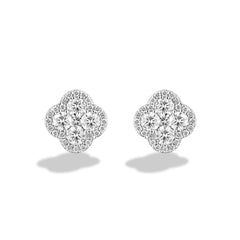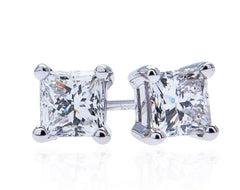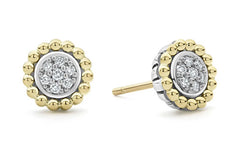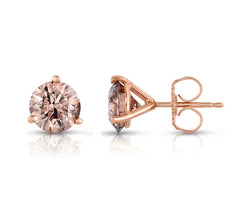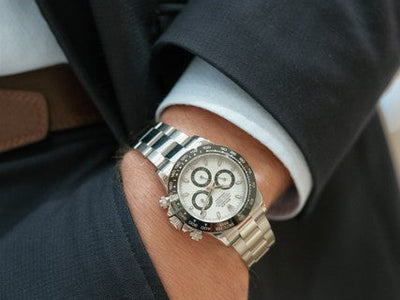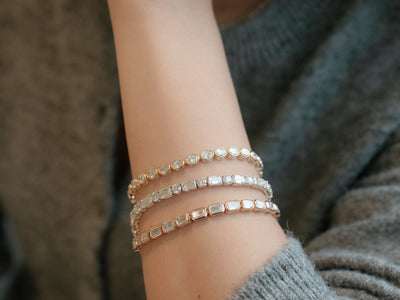When it comes to selecting the perfect pair of diamond stud earrings, there's more to consider than what catches your eye. While searching for your forever solitaire studs, it’s essential to walk through a mental checklist before purchasing on a whim. We know - it's hard to resist when you stroll by a window with a stunning pair of real diamond earrings calling your name.
If you do a little research and plan your purchase responsibly, it will ensure you invest in high-quality jewelry that fits within your price range. Don't worry; you'll be showing off those brilliant diamond studs before you know it! So, whether you're treating yourself or purchasing diamond earrings as a gift, you won’t go wrong with our ultimate shopping guide!
5 Things to Consider When Buying Diamond Stud Earrings
- Diamond Earring Occasions
- A Bit of Earring History
- Selecting Your Diamond Stud Earrings
- Additional Tips for Buying Diamond Stud Earrings
- The Fifth C of Fink's Diamonds
Diamond Earring Occasions
Do you have your eye on a pair of diamond earrings for an upcoming event or special celebration? Perhaps you've had your heart set on gifting yourself your first pair of solitaire studs, just because. Or you may be searching for the perfect birthday, Christmas, or anniversary present for your special someone and want to present her with a pair of diamond stud earrings to grace her lobes. Whatever your reasons, diamond earrings in your favorite style are the ideal addition to any jewelry collection, regardless of the occasion.
Worn with daily, casual, or formal attire, a pair of dazzling diamond studs is a staple in a woman's wardrobe. From running errands to an evening out on the town, their versatility and classic style are timeless.
A Bit of Earring History
For over five millennia, women and men have worn various ear ornaments, both in or on the lobes or cartilage. Yet, most people are unaware of how ancient earrings are and the intriguing history they hold throughout various cultures.
The piercing of the lobe is one of the oldest known body modification forms. The earliest earrings have been discovered throughout many regions.
Early evidence of earrings has been found throughout:
- Asia
- Egypt
- Rome
- Mesopotamia
- Persia
- Greece
In many cultures, earrings were initially worn only by royalty and the wealthiest of families. After all, they were among the only groups who could afford the lavish accessories.
Another Status Symbol
In earlier times, earrings, brooches, chains, and bracelets could be seen draped across the bodies of the elite. Jewelry collections could be seen dripping with gemstones and crowning the heads of royals.
Jewelry was generally a symbol of:
- wealth
- power
- marital status
- religion
- family lineage
Earrings soon became another decorative form of displaying one’s rank in society.
The First-Known Earring Styles
Some of the first styles to decorate earlobes were hoops and elaborate dangles. Men and women often pierced holes through their lobes to display rings, carved stone loops, and metal crescents.
Egyptians were known to use mushroom-shaped plugs inside enlarged lobe holes.
Archaeologists believe the oldest earrings ever found are nearly 8,500 years old. The jade rings were discovered in Inner Mongolia by the Chinese at the Xinglongwa culture site.
The Earliest Stud Earrings
One of the earliest forms of stud earrings was a popular piece in ancient Egypt. However, during the 1500s, wearing a simple, elegant pearl stud earring became quite popular.
Then, as fashion became more prominent in the 1600s, the earring trend began to come and go with the latest styles. It was common to see earring trends coincided with various women’s fashions, including bonnets and headdresses. Hairstyle changes also played a significant role in the earring trend. Many elaborate hairstyles kept the lobes hidden and the earrings at home, while up-dos were a chance to show off the lobes and neckline.
By the 1700s, gemstone earrings, particularly diamonds earrings, were especially popular.
In the 1800s, wearing an earring in just one ear grew in popularity.
The early 1900s saw pairs of earrings become more elaborate than ever amongst the wealthy.
Although the modern diamond stud earrings did not appear until the latter part of the 19th century, their popularity continued to rise through the 1970s. As a result, they remain an iconic staple in fashion today, thanks to their ability to pair well with any wardrobe item or jewelry piece.
Over the last couple of decades, diamond stud earrings have surged in crossover appeal. An ever-growing group of athletes, musicians, and celebrities alike wear them as singles, in pairs, or multiples. Quite often, you can see the entire ear engulfed in the brilliance of diamond earrings.
There's no question solitaire diamond studs are a historical extension of who we are. Since the 1950s, real diamond earrings have become somewhat more attainable to those outside the upper crust. In our growing desire to accessorize with fine, sparkly things, fashion has made diamond studs essential to every jewelry box. Their transitional ease from day to night, work to play, sneakers to heels make them a solid foundation to build any collection around.
Before you rush out to purchase the first beauties that tug at your heartstrings, let our diamond experts arm you with some helpful knowledge. You’ll have all your questions answered and know exactly what to look for in a high-quality pair of diamond studs. Let's dive into your ultimate guide to finding the diamond earrings that suit your every need.
Selecting Your Diamond Stud Earrings
Selecting a pair of diamond studs requires a bit more thought and planning than most people realize. If you're purchasing a gift, you may have a little investigating to do before you venture out to find your diamond earrings.
At Fink’s, we want to make sure we accommodate all your needs and desires. So if you visit one of our stores, we’ll walk you through the various options you’ll take into consideration when deciding upon your or your special someone’s diamond earrings.
When selecting diamond stud earrings, you’ll want to consider:
- your budget
- diamond carat weight
- diamond color
- diamond clarity
- diamond cut
- the shape of the diamonds
- type of metal
- metal color
Budgeting for Your Diamond Stud Earring Purchase
While it's easy to spend upward of $30,000 for diamond stud earrings, setting a realistic budget is critical before venturing out to make a purchase. Otherwise, your eyes may become larger than your wallet, and you could fall in love with a pair of diamond earrings that are financially out of your reach.
While it's certainly your prerogative, we suggest taking a quick mental inventory of your finances and diamond priorities before you begin. Then, establish a comfortable budget for your diamond earrings and be diligent. While your budget may ultimately help determine your diamond earring purchasing power, you will also want to be ready and equipped with the knowledge and tools necessary to prioritize and make a sound decision. This is where the expertise of our diamond experts can help! By providing you with valuable insight, you’ll be prepared to make an investment you can feel fantastic about.
The 4Cs to Buying Diamond Stud Earrings
Selecting the ideal pair of diamond stud earrings requires a bit of knowledge about the stones themselves. While you may be familiar with the GIA 4Cs of diamonds, we pride ourselves on offering a fifth C at Fink's, but we'll share that gem a bit later.
The 4Cs of a diamond are the standard in evaluating a stone's quality. In turn, each stone's quality helps establish its overall value and price. Therefore, careful consideration of each of the 4Cs will help you select the diamond earrings you envision wearing.
The 4Cs of a diamond include:
- carat weight
- color
- clarity
- cut
Selecting diamonds for your solitaire diamond studs works a bit differently than selecting a diamond for an engagement ring. While you certainly want the best quality for your money, you do have a bit of wiggle room while diamond earring shopping. We have put together a few helpful tips to guide you through narrowing down and selecting diamond stud earrings. First, let's take a close look at the 4Cs and where you may find opportunities to reevaluate some of your top priorities in a diamond.
Diamond Carat Weight
The carat weight is often mistaken for the size of a stone. Instead, carat weight refers to the diamond’s metric weight. This system allows the jeweler's measurements of a stone to be exact.
Metric weight is defined as 200 milligrams. Each carat is then subdivided into 100 points, providing a measurement down to the hundredth decimal.
While the value of a larger carat weight diamond can increase significantly, keep in mind, it does not do so independently. Your 1.00-carat real diamond earrings won't make nearly the impression if they lack brilliance from improper cut, clarity, and color.
If you'd like your diamond stud earrings to make a real statement, start your search with 0.50 carat stones. While carat weight is typically what catches the eye and makes a lasting impression, consider all 4Cs and not merely size alone. Your 1.00 carat diamond earrings won't make nearly the impression if they lack brilliance from improper cut, clarity, and color.
Diamond Color Rating
Without proper diamond color standards in the industry, jewelry shoppers were once at the mercy of a merchant. Diamonds were loosely placed into color categories A, AA, or AAA. No proper guidelines existed for assigning a diamond its category.
By 1953, GIA announced precise methods for the industry to follow in rating the color of a diamond consistently. Diamonds would now be assigned a rating on the D-to-Z Color Scale.
Diamonds can be found in an array of color grades. Therefore, the slightest difference between the color of two diamonds can significantly impact their value and price. In fact, to the naked eye, the slightest color variation between one diamond grade below or above a stone you’re considering may not be noticeable. However, the grading report and price of the real diamond earrings will provide precise information.
Fink's Jewelers is proud to offer only the highest quality in diamond color. Our stones can be found in our Superior Quality® color range, D-to-K.
Facets and Diamond Color
Color is one of those areas where you have a little room to adjust your priorities. The facets, or flat surfaces, you see on a diamond will act as tiny mirrors, reflecting objects close to them. As you inspect and compare stones, notice how the facets may enhance or affect the perception of the diamond stud's overall color.
There are two ways this insight can benefit your decision-making process. First, suppose you're watching your budget. In that case, you can save a bit of money by selecting diamond earrings slightly lower on the diamond color rating scale without sacrificing a noticeable color difference.
Or the money you save in the diamond color category can be used towards upgrading in one of the other 4C categories you’ve prioritized. This may be a prime opportunity to treat yourself to larger carat weight diamond earrings!
Diamond Clarity Scale
The GIA Clarity Scale was developed out of a need for consistency in determining a stone’s clarity. Clarity once used vague terms, such as “near perfect,” to describe a stone. The ethical guidelines and structure of the Scale put an end to the inconsistent and often misleading terms.
The clarity of a stone is determined by its inclusions, tiny imperfections within the diamond. A stone may also have blemishes, tiny imperfections found on the diamond’s surface. These imperfections are the results of intense heat and pressure a stone sustains as it is formed.
A diamond’s clarity is determined and graded by various factors. Grades are assigned after evaluating the number, size, and location of imperfections seen under 10x magnification.
The Clarity Scale provides precise guidelines for assigning a stone to one of six categories.
The 6 categories of the Clarity Scale include:
- Flawless
- Internally flawless
- Very very slightly included
- Very slightly included
- Slightly included
- Included
A Fink's diamond will not have inclusions visible to the naked eye. Standing by this promise ensures every diamond you consider at Fink’s meets our Superior Quality® standards.
At Fink's, we inspect each stone under a gemological microscope to further evaluate the stone's clarity. During this rigorous inspection process, our diamond expert is looking for several specific imperfections:
- Large feathers
- Dark inclusions
- Reflectors
- Large indented naturals
- Knots
Feather in the Diamond
We first look for the presence of a large feather, or fracture, in the diamond. Feathers will typically appear as a slightly white area and can be seen by the naked eye.
If a feather is at the surface of a stone, a cavity or small opening can be created.
Dark Inclusions Flaws
Dark inclusions are carbon spots that failed to crystallize properly. These inclusions have the appearance of tiny black spots and will cause your stone to appear dark and lack brilliance.
Reflectors in a Diamond
Next, we check for reflectors, which are mirrored images of an inclusion. While diamonds can reflect light magnificently, you do not want mirrored images of your stone’s inclusions.
Large Indented Natural Inclusions
Indented naturals are part of an original rough stone’s surface. It drops below the polished diamond’s surface. However, indented naturals are more of a type of flaw than a natural imperfection. Intended naturals are not removed.
Large indented natural inclusions are typically located on the girdle, or edge, of a diamond. They are often avoided because they can potentially affect the durability, brilliance, and overall appearance of a diamond.
Knots on Diamond Surface
And lastly, we look for knots found on the stone's surface. A knot is a crystalized inclusion that reaches the diamond’s polished surface. You can see where the surface and knot meet under magnification in just the right lighting and magnification.
A knot's location near the exterior may give the impression that a stone has a raised area on a facet. Unfortunately, this can usually be seen with the naked eye.
Knots may also affect a stone’s durability over time, so they should be carefully considered.
These imperfections can make a significant difference between a "good" SI2 vs. a "bad" SI2.
Let's take a look at the two diamond examples below. Although both stones are graded by the GIA and assigned an H color grade and SI2 clarity, there are noticeable differences between the two.
When the stones are viewed underneath high-powered magnification, the differences are undeniable. We can see many inclusions and a much cloudier appearance in the image to the right. The image of the stone on the left appears free of noticeable inclusions and has a bright sparkle.
Fink’s goes beyond the grading report to evaluate each diamond. Only the best diamonds fall within our Superior Quality Range. Therefore, only the diamond on the left will meet our strict criteria to become a Fink's Diamond, even though both carry the same GIA grading report.
While shopping for your diamond jewelry, it's essential to view the grading report, but even more vital to view the stone under a gemological microscope for yourself. There, you'll see the diamond for what it truly is. An established and reputable jeweler should be more than happy to assist you with your inspection when shopping for your diamond earrings.
Visibility and Clarity
While clarity is essential for most engagement ring shopping, you have more room for imperfections when selecting stones for your diamond studs. Your diamond earrings are less likely to show off your stone's blemishes and inclusions from your ear lobes, whether hidden behind a cascade of hair or not.
Selecting stones on the lower end of the diamond clarity scale allows you to save some additional money. Consider examining Slightly Included (SI1 and SI2) and Included (I1 and I2) stones, allowing you more options to reconsider the remaining 3 C’s.
The Diamond's Cut
If you want your diamond stud earrings to sparkle and shine - and who wouldn't - the cut of your diamond may be a higher priority than any other C on your list. Selecting stones with a brilliant-cut and facet arrangement will yield incredible sparkle. To better understand a diamond’s cut, let’s explore what it is, why it’s vital, and how it differs from a diamond shape.
What is the Diamond Cut?
The diamond’s cut refers to the stone’s dimensions and how proportionate they are. Cut also examines facets of a stone and how brilliance, sparkle, and fire are affected due to their positioning.
The brilliance of your diamond earrings may be determined most by the quality of its cut over any other factor. With each precise cut, a diamond’s ability to reflect light through it is magnified.
While all 4Cs of a diamond are critical to the overall quality of your diamond studs, the simple fact is its beauty may depend more on the quality and craftsmanship of the cut than anything.
The 3 critical components include:
- proportions
- symmetry
- polish
Why Diamond Cut is Vital
Diamond cut is essential in determining the overall performance of your diamond stud earrings. Selecting a well-cut stone creates a dazzling display of light reflection that can’t be denied.
The skilled craftsmanship that goes into a well-cut diamond is responsible for influencing three essential factors:
- Brightness: the total reflection of all white light from the diamond
- Fire: reflected light’s dispersion into colors of the spectrum.
- Scintillation: the creation of sparkle from a stone's movement as patterns of dark and light areas are present
A poor diamond cut may result in a lifeless, dull stone, regardless of its clarity and color grading. Diamond quality is maximized if the cut quality allows proper reflection and refraction of light.
Selecting the Shape of Your Diamond Earrings
The terms diamond cut and diamond shape are often used interchangeably. However, they are pretty different. The outline of your stone is referred to as the diamond’s shape, such as the unique pear-shaped diamond.
Diamond stud earrings come in an array of shapes. While we all have our preferences, let's take a look at the two most popular solitaire stud shapes:
Sabel Collection Round Cut Diamond Studs
The brilliant round cut is, by far, the most popular shape choice for diamond jewelry, and diamond studs are no exception. The round shape and exquisite cut of the stones enhance their sparkle, brightness, and fire. It's also an ideal choice if you happen to have a gorgeous round solitaire diamond engagement ring to pair with it.
Sabel Collection Princess Cut Diamond Studs
Many love the appeal of a square-shaped diamond, making the princess cut an easy choice for their diamond stud earrings. The princess diamond earrings offer exceptional shine and sparkle due to their modified-brilliant facet arrangement.
Selecting the Metal for Your Diamond Stud Earrings
Choosing the color of your stone is yet another personal preference to consider. Diamonds come in many breathtaking hues, including blues, blacks, pinks, browns, and yellows. While the colorless diamonds are the purest and typically the most expensive, a colored stone catches the eye of many.
Clarity, referring to the condition of any gemstone, is far less noticeable within colored diamonds. If you prefer a colored diamond, you will allow yourself more room to prioritize other areas, including carat weight.
Selecting the Metal for your Diamond Stud Earring Setting
Choosing the ideal metal for your diamond earring setting may be an easy task for some, while others need a bit more guidance. There are three considerations to make when selecting the right metal to pair with your diamond studs:
- weight
- color
- possible metal allergies
Diamond Earring Weight
Weight is not a specific factor most consider when selecting diamond earrings. However, it’s worth educating yourself on metal weights before you begin your shopping. Your efforts will help ensure your studs are a comfortable fit.
Platinum vs. Gold
Platinum is denser than gold, accounting for the heavier feel of the setting, regardless of its same-size appearance. While the differences may be slight, take a moment to hold and examine the metal options. Consider if your lobes have been sensitive to weight in the past. How long will you be wearing your diamond earrings at any given time? These considerations will help you decide which studs best suit your needs.
Multi-Metal Settings
Many settings will combine precious metals, such as gold and platinum. Alloyed metals help give them additional strength and durability. This is important to note since more precious metal is present in the platinum alloy setting. It will account for having a slightly heavier feel than a white gold alloy setting.
Metal Color for Earrings
Choosing the metal color for your diamond earring setting can be one of preference. Yet, there are other factors you may not have considered.
Diamonds are highly reflective gems, making the encasing metal's color an essential consideration in your selection. A platinum or white gold metal can even enhance the appearance of your diamond earring’s carat weight.
Conversely, some prefer their diamond studs to reflect contrast. A dazzling diamond set in a rich yellow gold metal setting is a stunning look. If your diamond earrings are nestled in a detailed setting, the contrast will accentuate the intricate details.
Metal Allergies and Sensitivities
If you have an allergy to specific metals, you are not alone. Unfortunately, many people struggle with sensitivities due to metals used in gold alloys, including nickel and copper. Here are a few helpful tips for selecting your ideal diamond earring metal setting if this describes you.
Tips for metal-sensitive lobes:
- Avoid yellow, white, and rose gold if you know you are extremely sensitive to these or other alloy metals.
- Platinum is hypoallergenic and ideal for lobes with metal allergies.
- Platinum reduces irritation and allergic reactions.
Additional Tips for Buying Diamond Stud Earrings
Settings are critical to the security of your diamond earrings. While your setting's appearance is undoubtedly a significant consideration, don't neglect its role in securing your stone. It will secure your peace of mind as well.
Select a Setting with Optimal Security
The security of your diamond earrings relies on the protection your setting offers them. Keep in mind, a minimal coverage setting may maximize the appearance of your stone's size, but it also provides the least amount of protection. Lack of a secure setting can lead to the loss of a diamond, particularly with larger carat weight stones.
Bezel settings offer your diamond earrings the most protection but cover more stone areas to secure their position.
Selecting Earring Backings for Additional Diamond Earring Security
While many don't consider their earring backings upon initial purchase, this is an essential step in securing your investment. First, examine the backings of the diamond earrings you have your eye on. High-quality diamond earrings should offer you locking backs or screw backs for optimal security.
Additional safety backings for your diamond earrings include friction backs in a variety of sizes.
If you do experience a problem with your diamond studs, rest assured jewelry repair by a reputable team can get your precious diamond jewelry looking as good as new.
Diamonds of a Different Color
You may wish to consider thinking outside the box for your diamond studs or gifted diamond earrings. Diamonds come in many breathtaking hues, including the most popular blues, blacks, pinks, browns, and yellows. While the colorless diamonds are the purest and typically the most expensive, a colored diamond is deemed unique and catches the eye of many.
You may also be interested in knowing clarity is more forgiving, as imperfections are far less noticeable within colored diamond earrings. If you happen to prefer a pair of colored diamond studs, you will allow yourself more room to prioritize other areas.
Choosing the color of your stone is often a personal preference. However, if you’re purchasing real diamond earrings for a loved one, you may be unsure of their preferences. Enlisting the help of friends or family is always helpful before venturing out to buy her diamond earrings.
Pairing Your Diamond Earrings
 Your diamond earrings may be the first of your fine jewelry collection or just your latest addition. Whichever the case may be, there's one more consideration to make while shopping for your perfect diamond studs.
Your diamond earrings may be the first of your fine jewelry collection or just your latest addition. Whichever the case may be, there's one more consideration to make while shopping for your perfect diamond studs.
Ask yourself how you will accessorize your current and future jewelry pieces with the solitaire studs you’re about to purchase. While diamond stud earrings are incredibly versatile, it's still helpful to envision how you will pair them with various jewelry pieces. For example, perhaps you own, or dream of a sparkling princess cut tennis bracelet set in white gold. Envisioning your future pairings may help you select the diamond earrings that are a perfect match for this piece.
The 5th C of Fink's Diamonds
You'll recall we mentioned a fifth C we rely on for every diamond we select. For more than two decades, our family-owned jewelry stores have relied on the expertise of Clif, our fifth C of diamonds.
Clif hand-selects every Fink's diamond you see in our stores and on our website. While typical jewelers buy in large groups of diamonds – usually all within one grading range – he individually inspects each stone in its entirety.
Our trusted jeweler ensures each diamond meets his high stands by offering optimal cut, light performance, brilliance, and durability. His meticulous methods lead him to reject nearly 99% of the diamonds he inspects every year, regardless of its impressive grading report. Now that's a quality you can trust in a jeweler.
Clif has a motto he lives by, "If I wouldn't place it on my wife's finger, it's not good enough to be a Fink's diamond.” Our diamonds are also backed by our Lifetime Diamond Guarantee.
Now that you’ve been provided the knowledge, you’re more than ready to begin your earring shopping for yourself or a loved one. Our fine jewelry experts hope to assist you with your diamond stud purchase and all your fine jewelry and timepiece needs soon!



